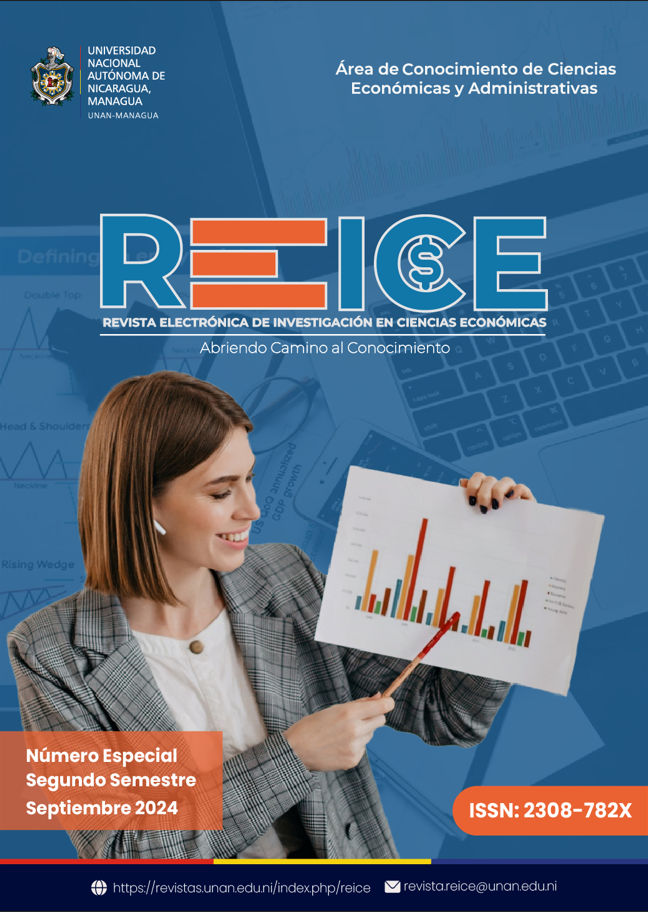Exploring the heterogeneous effects of the investment climate on employment and productivity in Nicaragua
DOI:
https://doi.org/10.5377/reice.v1i2.18867Keywords:
Investment climate, Business performance, Microenterprises, Financing, Electrical infrastructureAbstract
Using data from the World Bank's 2010 and 2016 Enterprise Survey, this research analyzes how the business climate affects the performance of Nicaraguan companies. The cell average method was used to prevent endogeneity, where each firm faces the average investment climate conditions of the activity and size to which it belongs in the initial period, instead of its own conditions at the current period. The results confirm that there are significant differences in the investment climate conditions and their effects are non-linear. Microenterprises increase employment and productivity with access to financing but face greater credit restrictions. The regulatory burden also affects companies differently depending on their size: large companies face more inspections and perceive customs regulations as significant obstacles but are more efficient in handling them. Microenterprises, although they spend less time on regulations, face higher relative costs due to informal payments and practices, which negatively impact their growth. Deficiencies in electrical infrastructure have a dual negative effect: they affect employment growth by microenterprises, suggesting that these companies are unable to substitute capital for labor to mitigate these problems, and they also affect the productivity of large companies.
Downloads
283
References
Arias Diaz, O. S., Perry, G. E., Maloney, W. F., Fajnzylber, P., Mason, A. D., & Saavedra-Chanduvi, J. (2007). Informalidad: Escape y exclusión (Primera edición). Mayol Ediciones S.A. https://documents1.worldbank.org/curated/en/889371468313790669/pdf/400080PUB0SPAN101OFFICIAL0USE0ONLY1.pdf
Aterido, R., Hallward-Driemeier, M., & Pages, C. (2009). Big Constraints to Small Firms’ Growth? Business Environment and Employment Growth across Firms. Economic Development and Cultural Change, 59, 609-609. https://doi.org/10.1086/658349
Besley, T., & Burgess, R. (2004). Can Labor Regulation Hinder Economic Performance? Evidence from India. https://www.researchgate.net/publication/24091856_Can_Labor_Regulation_Hinder_Economic_Performance_Evidence_from_India_CEPR_Discussion_Paper_3260
Bigsten, A., Kimuyu, P., & Lundvall, K. (2000). Informality, Ethnicity and Productivity: Evidence from Small Manufacturers in Kenya.
Botero, J. C., Djankov, S., Porta, R. L., Lopez-De-Silanes, F., & Shleifer, A. (2004). The regulation of labor. Quarterly Journal of Economics.
Byiers, B. (2009). Informality in Mozambique: Characteristics, Performance and Policy Issues. https://www.acismoz.com/wp-content/uploads/2017/06/Byiers_InformalityInMozambique_18%2011%2009.pdf
Coad, A., Daunfeldt, S.-O., Research, H., & Halvarsson, D. (2014). Firm age and growth persistence.
Demirgüç-Kunt, A., & Maksimovic, V. (1998). Law, Finance, and Firm Growth. The Journal of Finance, 53(6), 2107-2137. https://doi.org/10.1111/0022-1082.00084
Djankov, S., Porta, R. L., Lopez-De-Silanes, F., & Shleifer, A. (2002). The regulation of entry. Quarterly Journal of Economics. https://scholar.harvard.edu/files/shleifer/files/reg_entry.pdf
Gómez Sabini, J. C., & Morán, D. (2012). Informalidad y tributación en América Latina: Explorando los nexos para mejorar la equidad (124; Macroeconomía del desarrollo). CEPAL. https://repositorio.cepal.org/server/api/core/bitstreams/bd8e7674-043b-4a2c-8da6-2ddff8204520/content
Hallward-Driemeier, M., & Pritchett, L. (2015). How Business is Done in the Developing World: Deals versus Rules. Journal of Economic Perspectives, 29(3), 121-140. https://doi.org/10.1257/jep.29.3.121
Hallward-Driemeier, M., Wallsten, S., & Xu, L. C. (2003). The Investment Climate and the Firm: Firm-Level Evidence from China (SSRN Scholarly Paper 373946). https://papers.ssrn.com/abstract=373946
Haltiwanger, J., Jarmin, R., & Miranda, J. (2011). Who creates jobs? Small versus large versus young. https://www.google.com/search?q=Who+creates+jobs%3F+Small+versus+large+versus+young&rlz=1C1ONGR_esNI1023NI1023&oq=Who+creates+jobs%3F+Small+versus+large+versus+young&gs_lcrp=EgZjaHJvbWUyBggAEEUYOdIBBzY5MGowajeoAgiwAgE&sourceid=chrome&ie=UTF-8
Ingram, M., Ramachandran, V., & Desai, V. (2007). Why Do Firms Choose to be Informal? Evidence from Enterprise Surveys in Africa. https://documents1.worldbank.org/curated/zh/665731468194662235/pdf/419710AFR0Info1rms0rped13401PUBLIC1.pdf
Klapper, L., Laeven, L., & Rajan, R. (2006). Entry regulation as a barrier to entrepreneurship. Journal of Financial Economics, 82(3), 591-629. https://doi.org/10.1016/j.jfineco.2005.09.006
Loayza, N. (1997). The Economics of the Informal Sector. A Simple Model and Some Empirical Evidence from Latin America. https://documents1.worldbank.org/curated/en/685181468743710751/pdf/multi0page.pdf
Lora, E., & Cortés, P. (2001). Obstacles to Business Development and the Size of Firms in Latin America.
Narvaez, A. B., & Rivera, F. C. (2016). Determinantes de la informalidad en Nicaragua. https://www.bcn.gob.ni/sites/default/files/revista/trabajos_volIII/Brenes_y_Cruz_2016.pdf
Pitelis, C. (2009). Edith Penrose’s ‘The Theory of the Growth of the Firm’ Fifty Years Later. SSRN Electronic Journal. https://doi.org/10.2139/ssrn.1477885
Rajan, R., & Zingales, L. (1996). Financial Dependence and Growth (w5758; p. w5758). National Bureau of Economic Research. https://doi.org/10.3386/w5758
Soto, H. de. (1989). The Other Path: The Invisible Revolution in the Third World. Harper & Row.
Urcuyo, R. (2012). Microfinanzas y pequeñas y medianas empresas en Nicaragua.
World Bank. (2011). The Nicaragua 2010 Enterprise Surveys Data Set.
World Bank. (2014a). Doing Business 2015: Going Beyond Efficiency. The World Bank. https://doi.org/10.1596/978-1-4648-0351-2
World Bank. (2014b). Promoviendo la competitividad y el crecimiento inclusivo. Republica de Nicaragua, Memorando Económico de País.
World Bank. (2017). Description of Nicaragua ES 2016 Implementation.
Downloads
Published
How to Cite
Issue
Section
License

This work is licensed under a Creative Commons Attribution-NonCommercial-ShareAlike 4.0 International License.
Copyright (c) Revista Electronica de Investigacion en Ciencias Economicas
The rights to the articles published in REICE are from the journal, in order to be able to manage their best dissemination. However, since the purpose of the same is the dissemination of knowledge, this journal provides immediate free access to its content, under the principle that making research available to the public free of charge, which fosters a greater exchange of global knowledge.
The opinions expressed by the authors do not necessarily reflect the position of the publisher of the publication or of the UNAN-Managua. Its reproduction and distribution is authorized (in any type of support) provided that the following indications are fulfilled:
- The authorship of the work
- Indicate its origin (REICE magazine, volume, number and electronic address of the document)

